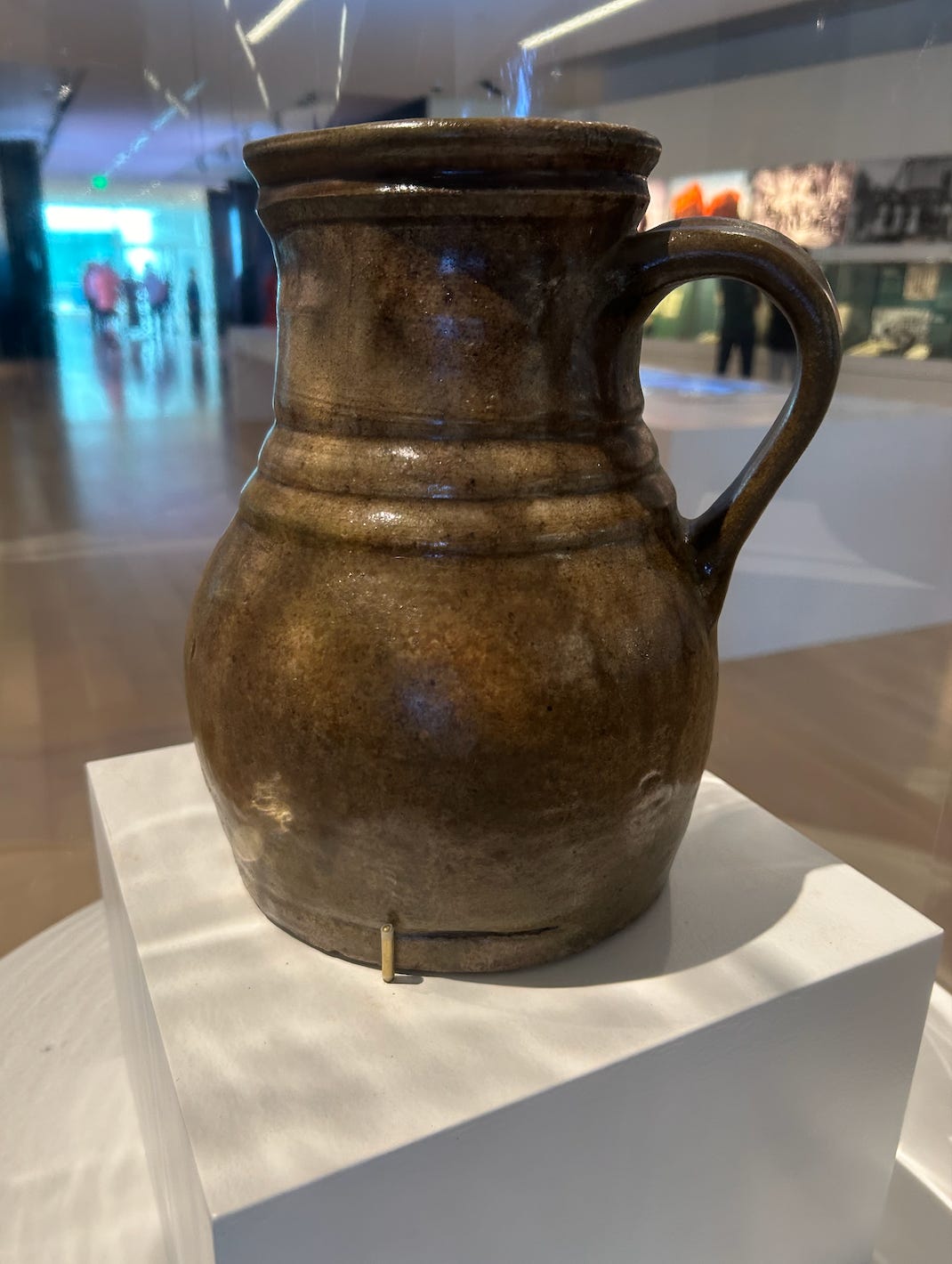My fascination with clay began in either my third or fourth-grade art class. My teacher shared with the class that we would be making face jugs. I remember being very fond of this teacher because before we made art, she made us weave threads of context through research. When she said that these vessels were created by people held captive in slavery I was hooked! It made clay feel accessible to me. Knowing that this practice was rooted & made from the Southern soil I was being raised in made it feel like I had a right to mold life from it. Knowing the context of face jugs made it feel like I could mold a life. This classroom was where I first heard the name David Drake. It wasn’t until a couple of weeks ago that I saw his work in person at the International African American Museum (IAAM).
David was labeled property but he was a sovereign human being. Many scholars, artists, & cultural workers refer to him as “Dave the Potter.” However, as the late great Toni Morrison reminds us “you are not the work you do, you are the person you are” (published in The New Yorker, “The Work You Do, The Person You Are,” May 29, 2017). This statement is especially helpful in the context of people who were held captive & labeled property. Edgefield, South Carolina’s system of slavery was different because it was based on industry (most notably pottery). The fact remains that it was still nonetheless slavery. Therefore, equating David with his forced profession causes complex points of tension to arise.
However, one thing I do know that is not complex is the fact that David Drake was a human being.
While some of these photos may be deceiving, this stoneware piece was surrounded by glass. While the curator in me understood the reason why, it was still disheartening to see the pitcher held captive. One of the things that makes Edgefield, South Carolina pottery so moving is the fact that people labeled property hands’ are on these gathered vessels. Whether the vessels were crafted by coil or slab method, their hand can be seen & I wanted to feel it. If the glass border was not present & I touched the pitcher the warmth of a palm would’ve been long gone. But perhaps the heat of a live hand, flowing with red river veins, would have dissipated into an invigoratingly crisp decoration… I was here.
I touched this clay under the surveilling eye who believed me to be his & made it my own.
I molded the vessel, the force tasked completed, & my tree ring fingerprints are preserved with the life of this pitcher.
I gathered this clay & from flat land erected something to pour into & give.
As I walked around this pitcher I pondered, what is this piece pouring into me? How do we pour back into the countless once-known Edgefield potters whose prints are all we now have?
My mapped palms hold the geographies of imprinted truth…I am a human being.
Is a glass wall the way to honor a marker of time & subjectivity? I dream of being able to go into a museum and touch a piece like this pitcher. Even if it was through a small cut out in the glass. I think something would shift in me. Earth-turned art transforms it into a fragile thing. This art from Earth suddenly becomes something worth protecting. As if the earth & land isn’t already inherently worthy of our protection. Unruly, rogue, wild, wayward, & vernacular folk know that the Earth is art. To many oppressive systems, Earth is not seen as valuable & worthy of protection until it is monetarily worth something. The same can be said for David. As a man, David was never protected but instead treated as property. David was never protected but his now profitable works of art are. The fallacy of empire always tells on itself.
David Drake’s hand is all over this pitcher & I wish I could’ve touched it to bring our palms together. Sometimes the act of holding hands is a ritual of trusting that two combined palms have the escape strategy.
While listening to David’s fourth-generation descendants discuss his work two quotes stood out to me.
“And it’s amazing how all of us have felt that he wants to be acknowledged by his strength, by his wisdom, to put himself in danger to write his thoughts on the pot.” — Pauline Bake Fourth-Generation Granddaughter
“He knew one day that somebody would see something in his art, his potteries. And this is the day, I believe, Dave saw.” — Daisy Whitner Fourth Generation Grandaughter
While David didn’t write any words on this piece, his hand is the message.
On the back lower right-hand side of David’s pitcher, there is a mark. Perhaps this mark can also be defined as a wobble or indentation. I’m unsure if this is a direct result of David’s hand, the firing process, or something that happened during the lifespan of the pitcher. What I do know is wanted to touch the handle, the three-ring lines outlining the neck, & that lower right mark.
I left IAAM feeling a bit of grief that our palms never touched. However, I was honored that I got to encounter the earth & the man (David Drake) who gathered & left a code.
Please remember if you choose to quote this piece, share this piece, or any piece on this publication to always CITE BLACK WOMEN. Please always include the name and link to the Assemblage: Baby’s Breath substack publication in your sharing practice.
To further support my writing practice, receive additional offerings that connect to my pieces, & be the first to hear about other ways to engage in the theory of assemblage, please consider becoming a paid subscriber.






